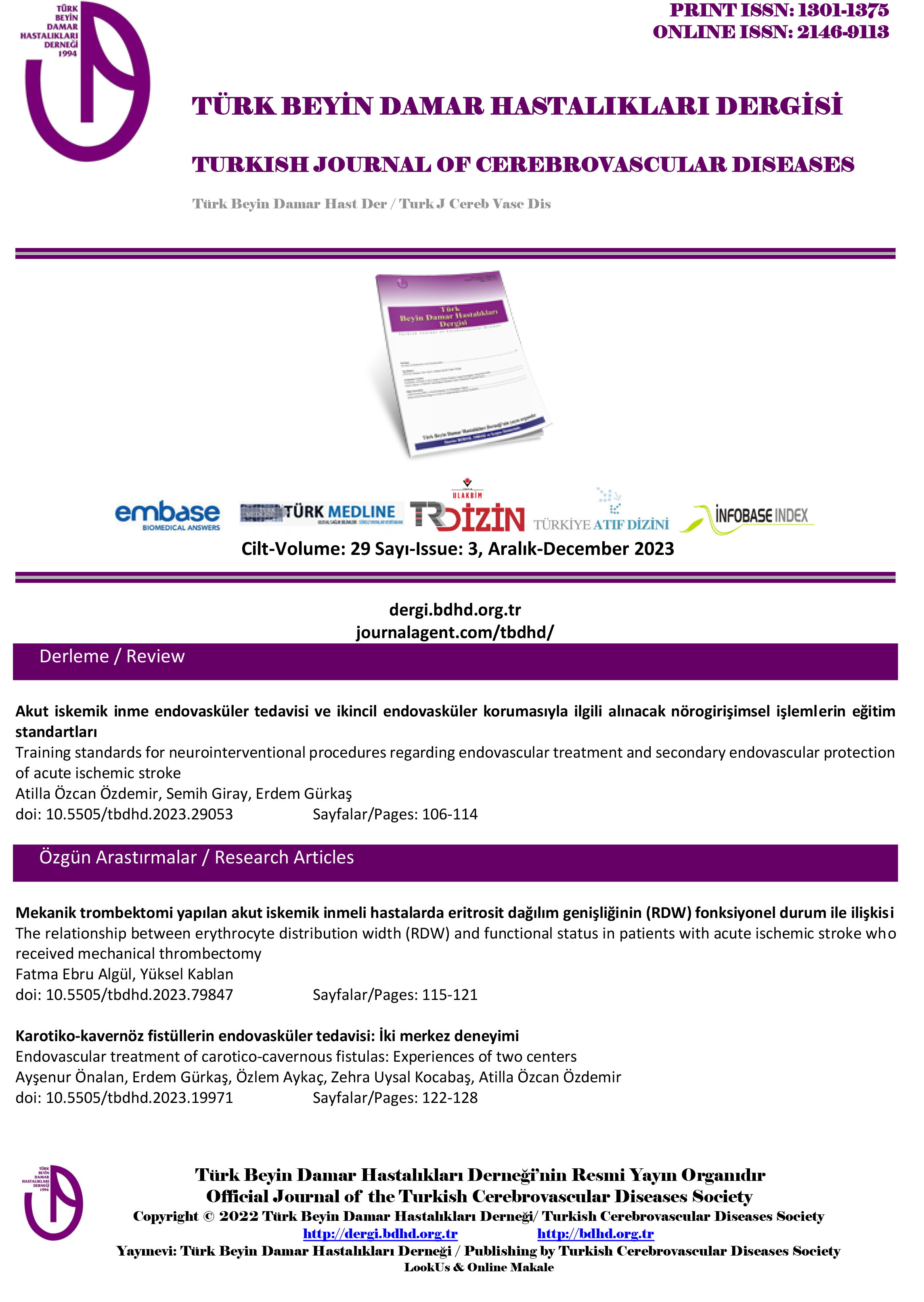Akut iskemik inmeli hastalarda geçici hipergliseminin inme prognozu üzerine etkileri
Soner Kılıç1, Murat Gültekin1, Ferhan Soyuer2, Kürşad Ünlühizarcı3, Ali Soyuer41Kayseri Eğitim Ve Araştırma Hastanesi Nöroloji Servisi, Kayseri2Erciyes Üniversitesi Halil Bayraktar Sağlık Hizmetleri Meslek Yüksek Okulu, Kayseri
3Erciyes Üniversitesi Tıp Fakültesi İç Hastalıkları Anabilim Dalı, Kayseri
4Özel Erciyes Kartal Hastanesi Nöroloji Servisi, Kayseri
AMAÇ: Bu çalışmada akut iskemik inmede geçici hipergliseminin sıklığı, hipergliseminin inme şiddeti ve inme prognozu üzerine olan etkileri incelenmiştir.
YÖNTEMLER: Çalışmaya akut iskemik inme nedeniyle başvuran ve çalışmaya alınma kriterlerini dolduran 100 hasta dahil edildi. Hastalar geliş kan şekeri, açlık kan şekeri, oral glukoz tolerans testi (OGTT) ve HbA1c değerine göre normoglisemik, geçici hiperglisemik ve diyabetes mellitus (DM) olmak üzere üç gruba ayrıldı. Bu hastaların ilk başvuruda ve takiplerinin üçüncü ayında NIHSS (National Institue of Stroke Scale), FM (FuglMeyer) ve FIM (Fonksiyonel Bağımsızlık Skalası) skorları belirlenerek inmenin şiddeti ve inme prognozu yönünden karşılaştırılmaları yapıldı. Ayrıca hiperglisemik ve normoglisemik olan hastaların üçüncü aydaki açlık kan sekerine göre, kalıcı DMye dönüşümü incelendi. Analiz için ANOVA, Paired t resti, ve Mann-Whitney U testi kullanıldı.
BULGULAR: Hastaların 52si normoglisemik, 21i geçici hiperglisemik, 27si diyabetik olarak değerlendirildi. Takiplerinin üçüncü ayında 28 hasta eksitus olmuştu. Geçici hiperglisemili üç hastada daha sonra kalıcı DM gelişti. Hastaların ilk başvuruda ölçülen NIHSS, FM ve FIM değerleri ile belirlenen inme şiddeti normoglisemik hastalarda, geçici hiperglisemik ve diyabetik hastalara oranla daha düşük tespit edildi (p<0.05). Geçici hiperglisemik ve diyabetik hastalar arasında inme şiddeti arasında anlamlı fark yoktu (p>0.05). Her üç grup da inmenin üçüncü ayında anlamlı derecede iyileşme gösterdi (p<0.05). Normoglisemik grupta iyileşme en belirgin iken DMli grupta en az iyileşme görüldü.
SONUÇ: Bu çalışmada geçici hipergliseminin, iskemik inmeli hastaların önemli bir kısmını oluşturduğu ve hipergliseminin ne şekilde olursa olsun inmenin şiddeti ve prognozu üzerinde olumsuz rol oynadığı sonucuna varılmıştır. İskemik inmeli hastaların sekonder korunmasında geçici hiperglisemi takibinin önemli olduğu tespit edilmiştir.
The effects of temporary hyperglycemia on the prognosis of stroke in patients with acute ischaemıc stroke
Soner Kılıç1, Murat Gültekin1, Ferhan Soyuer2, Kürşad Ünlühizarcı3, Ali Soyuer41Kayseri Education And Investigation Hospital Neurology Clinic, Kayseri2Esciyes University Halil Bayraktar Vocational School Of Health Services
3Erciyes University Faculty Of Medicine Department Of Internal Medicine, Kayseri
4Erciyes Kartal Private Hospital Neurology Clinic, Kayseri
OBJECTIVE: In this study, frequency of temporary hyperglycemia and effects of the hyperglycemia on the severity and prognosis of stroke were examined in patients with acute ischaemic stroke.
METHODS: One hundred patients, who applied for acute ischaemic stroke and met the inclusion criteria, were included in the study. Patients were diveded into three groups: normoglycemic, temporary hyperglycemic and diabetes mellitus (DM), according to the baseline blood glucose, fasting blood glucose, oral glucose tolerance test (OGTT) test and HbA1c value. These groups National Institue of Stroke Scale (NIHSS), FuglMeyer (FM) and Functional Independence Measure (FIM) scores were measured at baseline and at the 3rd month of the follow up; then, these data were compared in terms of the severity and prognosis of stroke. In addition, according to the fasting blood glucose, hyperglycemic and normoglycemic patients becoming permanent diabetics were evaluated. ANOVA, Paired t test and Mann-Whitney U tests were used in the statistical analyses.
RESULTS: Of the patients 52 were normoglycemic, 21 were hyperglycemic and 27 were diabetic. At the 3rd month of the follow up, 28 patients died. Three patients with temporary hyperglycemia became permanent DM. At baseline, severity of stroke as measured by NIHSS, FM and FIM scores was lower, which was statistically significant (p<0.05), in patients with normoglycemia than in those with hyperglycemia or DM. The severity of stroke was not significantly different among hyperglycemic and diabetic patients (p>0.05). Each of the three groups showed significant improvements at the 3rd month after stroke (p<0.05). Normoglycemia group showed the more improvement than diabetic group.
CONCLUSION: In this study, it was concluded that temporary hyperglycemia was not infrequent in patients with ischaemic stroke, and that all forms of hyperglycemia played negative role in the severity and prognosis of stroke. It was determined that follow up of temporary hyperglycemia was important for secondary care of these patients.
Sorumlu Yazar: Murat Gültekin, Türkiye
Makale Dili: Türkçe










